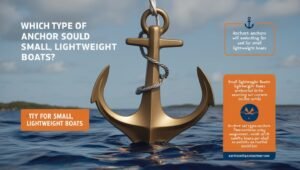
What type of anchor should only be used for small light boats?
For those out on the water with small, lightweight boats, choosing the right anchor is an important decision that affects not only the safety of the boat but also the safety of its occupants. Anchors serve as the primary means of securing a vessel in a stationary position, preventing it from drifting due to currents, winds, or waves. However, the challenge lies in choosing an anchor that is not only effective but also suitable for the size of the boat and the seafloor conditions it will encounter. In this comprehensive guide, we’ll explore the different types of anchors that are ideal for small, lightweight boats, and offer insight into their functionality, benefits, and specific situations in which they perform best.
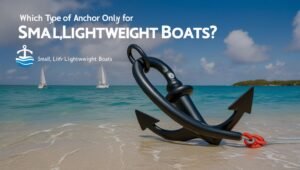
Understanding the importance of the right anchor
Before learning about the types of anchors, it is important to understand why choosing the right anchor for small boats is important. A properly selected anchor provides peace of mind, knowing your boat will stay securely in place, whether you’re fishing, swimming, or enjoying a day on the water. For smaller boats, improper anchoring can result in drag, ineffective holding, or even difficulty retrieving. Additionally, smaller boats are more sensitive to changes in wind and current, making choosing the right anchor even more important.
Important factors in anchor selection for small light boats
When choosing an anchor, several factors must be considered to ensure that it meets the specific needs of a small, lightweight boat:
Boat size and weight The anchor should be of appropriate size for the boat. An anchor that is too heavy may be difficult to handle, while one that is too light may not provide adequate holding power.
Seabed Conditions Different anchors perform better in certain types of seabed, such as sand, mud, rock, or grass. Understanding the general seabed conditions in the areas you visit is key to choosing the right anchor.
Weather and water conditions Consider the general weather and water conditions in your area. Strong winds, strong currents, and waves can affect the anchor’s holding power.
Ease of use Small boats often have limited space and equipment. Therefore, the anchor must be easy to deploy, retrieve, and store without taking up excessive space or requiring complicated handling.
Anchor Holding Power This is the ability of the anchor to resist movement after it has entered the seabed. High holding power is essential to ensure the boat stays in place.
With these factors in mind, let’s explore the different types of anchors that are best suited for small, lightweight boats.
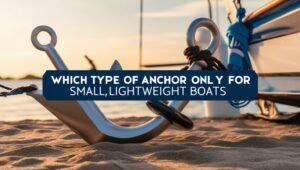
Types of anchors for small light boats
Danforth Anchor
The Danforth anchor, also known as a fluke anchor, is one of the most popular choices for small boats due to its lightweight design and excellent holding power in sandy and muddy seabeds. A Danforth anchor consists of two large, flat flocs that dig into the seabed when tension is applied. This design allows the anchor to provide a high holding power relative to its weight, making it ideal for smaller, lighter boats.
Advantages
Lightweight Easy to handle, making it perfect for smaller boats with limited deck space.
High holding power: particularly effective in sandy and muddy conditions.
Easy to store Its flat design allows it to be stored compactly.
Disadvantages Limited Performance in Rocky or Weedy Areas: The Danforth Anchor may struggle to set in rocky or weedy seabeds.
Low holding power in soft muds Although effective in firm soils, it may lose some holding power in very soft, silty muds.
Best Uses The Danforth Anchor is best used in sandy or muddy seabeds, where its floes can dig in effectively, providing a secure hold for small boats.
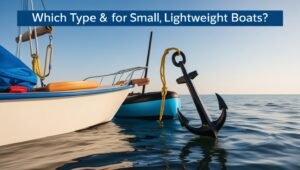
Bruce (Panj) Anker
A bruce anchor, commonly called a claw anchor, is another great option for smaller, lighter boats. It is known for its versatility and ability to perform well in a variety of seabed conditions, including sand, mud, and even some rocky areas. The claw anchor design features single-piece construction with three claws that allow it to be set quickly and reliably.
Advantages
Versatile Performs well in a range of seabed conditions including sand, mud and light rock.
Easy to set The claw design allows it to be set quickly, even if the boat moves after leaving the anchor.
Durable Made of strong material, it is resistant to bending or breaking.
Disadvantages:
Bulkier Design Takes up more storage space than the Danforth Anchor.
Heavy Although still manageable, it is heavier than some other anchors designed for smaller boats.
Best Uses Bruce Anchor is best suited for small boats that often navigate varied seabed conditions, where stability is key.
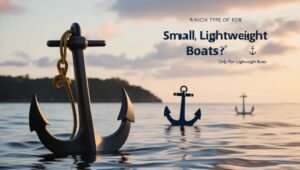
Grapple anchor
A graben anchor is a small, lightweight anchor commonly used for small boats, kayaks, and dinghies. It has a compact, folding design with multiple tines or arms that are attached to the seabed. Grippin anchors are particularly useful in rocky or coral environments where the tines can catch on protrusions for a secure hold.
Advantages
Compact and Foldable Easy to store and transport, it is ideal for small boats with limited space.
Useful in rocky conditions Tines can be attached to rocks and coral, providing a firm hold.
Inexpensive: Generally more affordable than other types of anchors.
Disadvantages Limited holding power in soft seabeds: Grapple anchors are not effective in sand or mud, where they may have difficulty digging in.
Can get stuck Tines can get stuck in rocks or debris, making recovery difficult.
Best Uses: A graben anchor is best suited to rocky or coral seabeds, where its tines can be folded downwards for a secure hold.
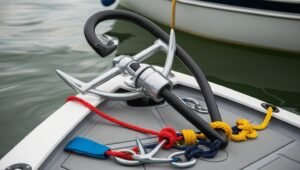
Mushroom anchor
The mushroom anchor is named for its shape, which resembles a mushroom cap. This type of anchor is designed to create suction when buried in soft seabeds such as mud or silt. Mushroom anchors are typically used for small, lightweight boats in calm, protected waters.
Advantages
Best in soft mud The mushroom shape creates a strong suction effect in soft seabeds, providing a secure hold.
Simple design easy to use and deploy, with no moving parts.
Environmentally friendly: causes minimal disturbance to the seabed.
Disadvantages
Limited use Only effective in very soft mud or silt, and not suitable for other types of seafloor.
Not ideal for strong currents Mushroom anchors may not hold well in areas with strong currents or strong winds.
Best Uses Mushroom anchors are best used in soft, muddy bottoms in calm, protected waters.
